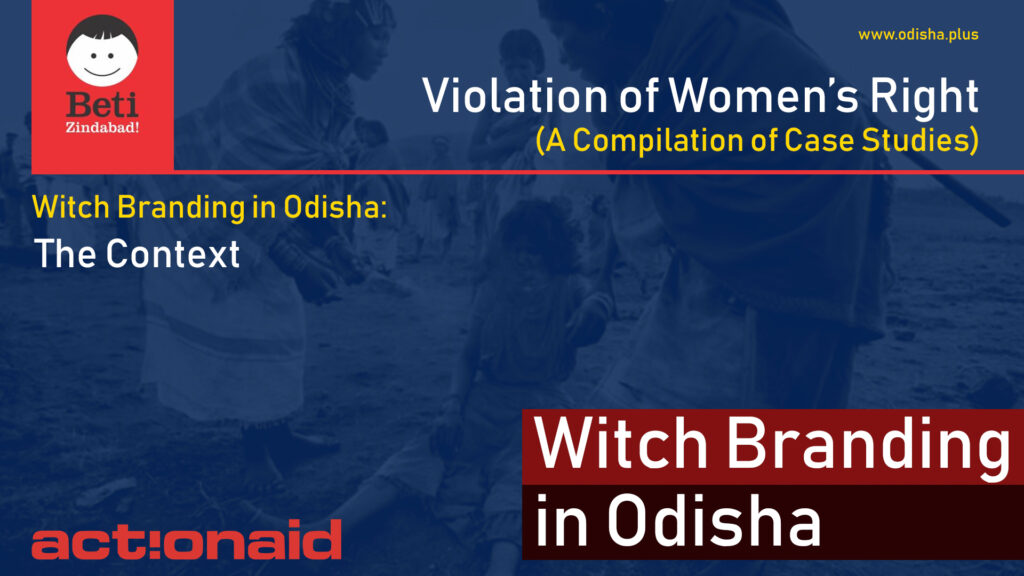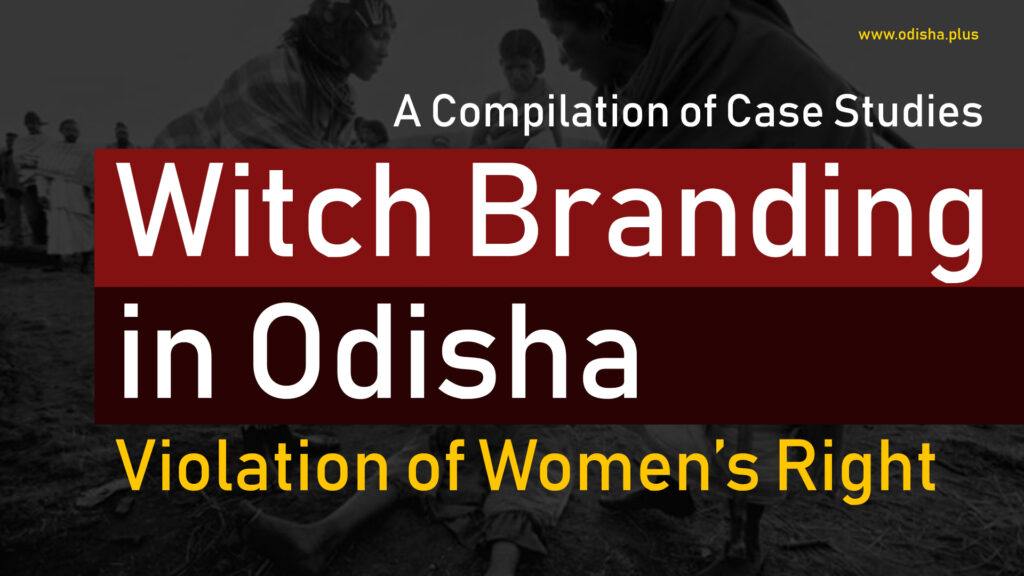OdishaPlus Bureau

Background:
The widespread practice of witch-hunts in geographically and culturally separated societies (Europe, Africa, India, and New Guinea) since the 1960s has triggered interest in the anthropological and sociological background of this behaviour. Belief in witchcraft has similarities in societies throughout the world. It presents a framework to explain the occurrence of otherwise random misfortunes such as sickness or death, and the witch sorcerer provides an image of evil. Reports on indigenous practices in the Americas, Asia and Africa collected during the early modern age of exploration have been taken to suggest that not just the belief in witchcraft but also the periodic outbreak of witch-hunts is a human cultural universal.
Women’s Rights Violation due to Witch Branding:
Of all the abuses of rights around the world, violence against women is one of the most widespread. One in three women worldwide will be raped, assaulted, or physically or sexually abused in her lifetime. For many women it can be almost impossible to defend themselves against violence because their voices are unheard and they have very little support available to them.
The issue of witch branding of women in Ghana and making further violence on them are linked to the whole issue of gender inequality in the country. When women are younger, more useful to society, they are in their child bearing years, they are working and have a husband and are conforming to what society expects, then there is no problem and no one will accuse them of behaviour which might then be attributed to witchcraft. But most of those accused are older, usually they are widowed and no longer looking after children and living alone on the edge of society. Then they become a target because they are no longer useful to society and not conforming to what people expect.
Accusations of witchcraft are a convenient excuse for the cruel treatment of women who are poor, excluded, different, or seen to be challenging the status quo. Very occasionally women who are economically successful and independent are accused, as a way of taking away their wealth and power. Women who are outspoken are also often accused of being a witch.
In northern Ghana hundreds of women accused of witchcraft by relatives or members of their community was living in ‘witch camps’ after fleeing or being banished from their homes. The camps, which were home to around 800 women and 500 children, offer poor living conditions and little hope of a normal life. The women had fled discrimination, threats or even mob justice after being accused of witchcraft and blamed for ‘crimes’ such as causing sickness, droughts or fires, cursing a neighbour or even just appearing in someone’s dream. Those who reached the witch camps were the lucky ones. Women had been murdered after accusations of witchcraft. Recently a mother of three was beaten and set on fire after being blamed for making a child sick through witchcraft.1 In 2010, the case of a 72-year-old woman who was set on fire and killed made headlines around the world.2
Some elderly women had lived in the camps for as long as 40 years – abandoned by their families and trapped in the camps until they die. Their only companions were young girls, often granddaughters or family members, who were sent with the women as ‘attendants’. Most of these girls had never gone to school, or had dropped out, and even when they reached the age when they could leave the camps, they usually could not because they were tainted by the word ‘witch’.

In 2011 the Ghanaian government announced that the witch camps should be closed down as soon as 2012. ActionAid was firmly against the closure of the camps in such as short space of time, because although they could be seen as ghettos, the camps provided a safe haven for women accused of witchcraft. The women themselves said they would prefer to stay in the camps rather than face discrimination or risk violence or death back home.
ActionAid led an anti-witch camp campaign with the ultimate aim that all the women labelled as witches are able to leave the camps and be safely reintegrated into society. There is a widespread belief in witchcraft in Ghana, as in many other countries. Though both men and women could be accused of witchcraft, the vast majority were women, especially the elderly.
Women who do not fulfil expected gender stereotypes, for example if they are widows, unmarried or cannot have children, are vulnerable to being branded as witches. ActionAid believes the witch camps are a cruel manifestation of gender inequality and violence against women in Ghana, as well as a denial of the rights of the women and girls who live there.
The camps only exist in the northern region of Ghana, where poverty levels are far higher than other areas of the country. ActionAid has been working in the camps since 2005 to provide basic services such as food, water, shelter and education. In recent years the focus is also on enabling the women to organise themselves, learn about their rights and fight for improved services and access to social benefits. They now feel self-confident enough to be leading the campaign to prevent the immediate closure of the camps, through marches, media engagement and community education.
ActionAid has conducted a study on witch hunting in the States of Madhya Pradesh and Chhattsigarh of India in terms of collecting case studies. The purpose of the study was to identity factors responsible for prevalence of witch branding of women as one of the heinous crimes against women. The study findings revealed that in each of the case direct or extended members of the survivor victim’s family had used the popular belief in”tonhi” in dispossessing the women of her ownership over land, however small. In the cases studied, persecutors and survivor victims belonged to tribal, Dalit and OBC category. In most of the cases, an FIR appears to have been lodged with the local police station. In any case, the IPC sections used in these cases to register such cases of witch hunting had been IPC 342, 354, 341, 290 ,323, 324k, 325, 506, or 34.
Except for 307 (attempt to murder), all the other sections were bailable offence. It was observed during the study that the accused were out on bail and the women continue to feel threatened. Despite cases against the accused and arrest made, survivor victims continued to face mental agony of being stigmatized as a “tonhi”. The stigma of “tonhi” seemed to have left an indelible mark in the lives of women. The presence of women organization supported the victims in filing the case. Along with the above findings the study recommended to undertake a review of implementation of law, consultation at national level for a central law, holding meeting with women’s group for capturing their experience and exclusive meeting with feminist lawyers to understand the existing laws. [4]
In Odisha the deplorable practice of witch hunting is rampant and women and their family members are succumbing to senseless violence. Hundreds of cases of witch hunting can be found in the 5 years crime statistics against women in the state of Odisha. According to the status given in the Study of Odisha Rationalists Society (ORS), 152 people were killed between 2010 and June 1, 2012. Every year, a good number of persons are killed in the name of superstitions and black magic. Witch-hunting casualties are on the rise across the State as 56 persons were killed in 2010, 72 persons in 2011 and 24 persons in 2012. According to data from the National Crime Records Bureau, Odisha saw 177 murders for ‘witchcraft’ during this period from 2008-2013[5]. Under culpable homicide not amounting to murder Odisha accounted for 75% cases due to ‘Witchcraft’ [6].
For an extensive period, witch branding was understood as a superstitious. But over the period many studies have been undertaken and explained that witch branding in many a times are committed by men on women. This act of branding woman as witch is due to their refusal to abdicate their rights or strong assertion over their rights. It has been observed that in most of the cases single women like widow, never married, and separated etc are more vulnerable to this kind of witch branding since they are not in a position to either defend or having the support of others.
Looking at this context and seriousness of the violence against women, the State Government of Odisha brought the ‘Odisha Prevention of Witch Hunting Bill-2013’ during December 2013 following the notice issued by High Court file counter to PILs seeking introduction of an act against witch-hunting. For the implementation of the legislation, a set of activities with benchmarks and indicators needed to be set within a framework with a comprehensive and coordinated approach where the different stakeholders were to be provided with capacity building about their specific roles and responsibilities.
There is no significant achievement of efforts on the ground to clamp down on witch-hunting in the state even as the Odisha Prevention of Witch-hunting Act, 2013 became enforceable in February 2014. Some of the gaps in implementation of the Act are mentioned below in brief:
- The Act empowers the government to organise awareness programmes against superstition and witch-hunting however there is no visible efforts to create awareness on the ground especially in the districts in which it is rampant such as Ganjam, Gajapati, Mayurbhanj, Sundergarh, Keonjhar, Malkangiri, Koraput and Raygada of Odisha.
- Police personnel also lack awareness on the issue as a consequence they refer IPC instead of The Odisha Prevention of Witch Hunting Act; 2013 while dealing the cases of witch hunting.
- There is a further demand for health care facilities, especially for tribal areas, as lack of health infrastructure made it easy for witch doctors to thrive.
(Source: ‘Witch Branding in Odisha: Violation of Women’s Rights’, a compilation of Case Studies by ActionAid, Odisha.)






















